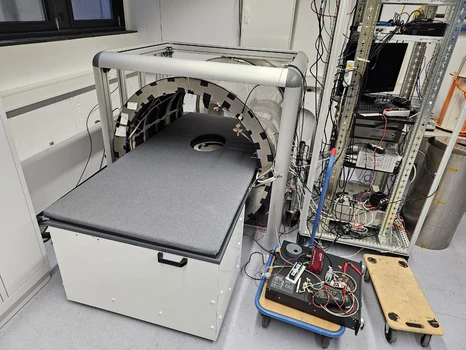Magnetic Shielding Development
Overview
The goal of this research is the development of new passive and active magnetic shielding concepts that enable compact, transportable Magnetocardiography (MCG) and fetal MCG (fMCG) systems.
By reducing the size and complexity of traditional magnetically shielded rooms, the project aims to make magnetocardiographic diagnostics possible in standard clinical environments such as doctors’ offices or perinatal centers.
This work combines simulation, signal analysis, and experimental validation to optimize shielding performance, reduce noise sources, and improve the overall signal-to-noise ratio (SNR) in compact MCG systems.
Shielding Optimization and Noise Reduction
The prototype setup is used to test new passive and active shielding methods. The experimental part of the project focuses on identifying, modeling, and mitigating magnetic noise sources:
- Environmental noise (power-line harmonics, building fields),
- Mechanical coupling (vibration-induced flux changes),
- Electronic and Johnson noise (shield material and sensor electronics).
A hybrid shielding system is under development, consisting of:
- a compact inner shielding pot made of μ-metal which contains the sensitive magnetometers, an outer shield as well as additional shielding geometries from μ-metal or Metglas forms the passive shielding
- a movable outer coil frame (Helmholtz and gradient coils) for active field compensation,
- and a low-noise feedback control system (here are analog PID and digital control loops under investigation).
The effectiveness is assessed through Low-Frequency Spectral Density (LSD) and coherence analysis between internal and external field sensors.
Novel Shielding Geometries and Machine Learning Optimization
To further improve shielding efficiency, new compact geometries are being developed using:
- Finite Element Modelling (COMSOL) for field simulation,
- and Physics-Informed Neural Networks (PINNs) for fast, data-driven optimization of geometry and current distributions.
PINNs are trained on COMSOL-generated datasets to predict optimal combinations of shield thickness, opening geometry, and coil configuration, reducing the computation time by orders of magnitude.
This allows rapid exploration of design trade-offs between accessibility, weight, and magnetic performance — a critical step toward clinically deployable fMCG systems.
Outlook
The combination of compact shielding, adaptive active compensation, and advanced data analysis will pave the way toward a portable fMCG system capable of operating in unshielded or lightly shielded environments.
Such a device would represent a major step toward the clinical translation of magnetocardiography, enabling non-invasive cardiac diagnostics from pregnancy to adult medicine.
Contact
For collaboration, thesis opportunities, or further inquiries, please contact:
M.Sc. Lena Wunderl
- Tel.: +49 (89) 289 - 53716
- Raum: 5117.02.304
- lena.wunderl@tum.de
Publications and finished Theses
Involved Persons and Former Members
Currently Involved persons: Lena Wunderl
Former Members:

